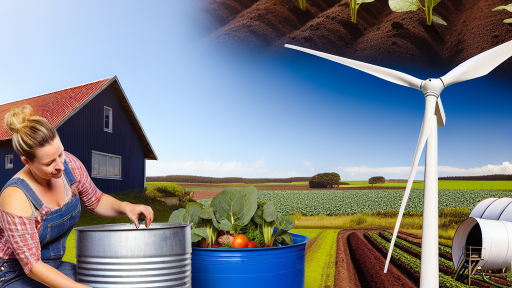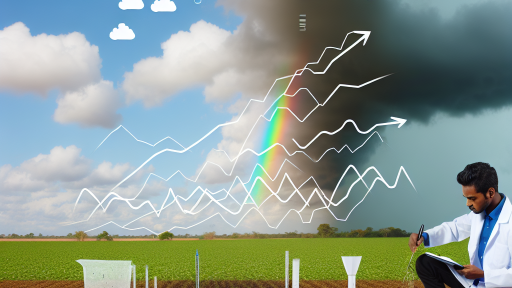Understanding Soil Emissions
An Overview of Greenhouse Gases Released from Soil
Soyl serves as a significant source of greenhouse gas emissions.
Different processes contribute to these emissions, impacting climate change.
Primarily, soils release carbon dioxide, methane, and nitrous oxide.
Each gas affects the atmosphere in unique ways.
Carbon Dioxide Emissions
Carbon dioxide is the most abundant greenhouse gas emitted by soils.
This gas is produced through soil respiration.
Microbial activity and organic matter decomposition drive this process.
Additionally, soil disturbance can increase carbon release.
Methane Emissions
Methane emissions from soils occur in anaerobic conditions.
This situation typically arises in waterlogged soils.
Wetlands and rice paddies are key contributors.
Methanogens, a type of microorganism, produce methane in these environments.
Nitrous Oxide Emissions
Nitrous oxide is another significant greenhouse gas released from soils.
This gas results primarily from nitrogen fertilizer application.
Microbial processes, such as nitrification and denitrification, also play a role.
Transform Your Agribusiness
Unlock your farm's potential with expert advice tailored to your needs. Get actionable steps that drive real results.
Get StartedHigher soil moisture and temperature can further enhance emissions.
Factors Influencing Soil Emissions
Soil type, land management, and climate significantly influence gas release.
For instance, sandy soils typically release more carbon dioxide.
Additionally, intensive farming practices elevate nitrous oxide emissions.
Conversely, maintaining healthy soil can reduce overall emissions.
Reducing Soil Emissions
Implementing effective soil management practices can significantly lower emissions.
These practices include cover cropping, reduced tillage, and organic amendments.
Each technique enhances soil health and minimizes greenhouse gas release.
It is crucial to adopt holistic approaches for more sustainable agriculture.
The Role of Soil Organic Matter in Sequestering Carbon
Understanding Soil Organic Matter
Soi organic matter consists of decomposed plants and animals.
It plays a vital role in maintaining soil health.
Moreover, organic matter enhances nutrient availability for crops.
Additionally, it improves soil structure and water retention.
Carbon Sequestration Mechanism
Carbon sequestration occurs when carbon dioxide is captured and stored.
Soil organic matter acts as a carbon sink.
This mechanism reduces the amount of carbon dioxide in the atmosphere.
Healthy soils can capture significant amounts of carbon over time.
Benefits of Increased Soil Organic Matter
Higher levels of soil organic matter provide numerous benefits.
- Improved soil fertility enhances crop yields.
- Better water management reduces irrigation needs.
- Enhanced biodiversity supports ecosystem health.
- Increased resilience against climate variations.
Practices to Enhance Soil Organic Matter
Farmers can implement various practices to boost organic matter.
Cover cropping is one effective strategy.
Incorporating crop residues back into the soil also helps.
Additionally, practicing reduced tillage can preserve existing organic matter.
Rotational grazing encourages diverse plant growth, enhancing soil health.
The Importance of Soil Management
Effective soil management practices are crucial for sustainability.
Showcase Your Farming Business
Publish your professional farming services profile on our blog for a one-time fee of $200 and reach a dedicated audience of farmers and agribusiness owners.
Publish Your ProfileThey enable long-term carbon storage in the soil.
Consequently, healthier soils contribute to global carbon reduction efforts.
This supports climate change mitigation strategies.
By prioritizing soil organic matter, we can promote a healthier planet.
Conservation Tillage: Techniques and Benefits for Soil Health and Emissions Reduction
Overview of Conservation Tillage
Conservation tillage refers to a set of farming practices.
These methods minimize soil disturbance during planting.
They aim to improve soil structure and health.
Common techniques include no-till and reduced tillage.
Benefits for Soil Health
Conservation tillage enhances organic matter retention.
It protects the soil from erosion caused by wind and water.
The method promotes a diverse soil microbiome.
This diversity helps in nutrient cycling and pest management.
Impact on Emissions Reduction
Using conservation tillage can significantly reduce greenhouse gas emissions.
Less mechanical disturbance means lower fuel consumption.
Moreover, sequestering carbon in the soil becomes more efficient.
Healthy soils retain more moisture, lowering the need for irrigation.
Implementation Techniques
Farmers can adopt various practices to implement conservation tillage.
- Plan crop rotations to enhance soil fertility.
- Utilize cover crops to protect soil over winter.
- Employ precision agriculture to minimize inputs.
Challenges and Considerations
Transitioning to conservation tillage can pose initial challenges.
Farmers may face resistance from traditional practices.
Furthermore, understanding the long-term benefits is crucial.
Education and support for farmers can facilitate this transition.
Discover More: Optimizing Irrigation Practices for Carbon Sequestration
Cover Cropping: Enhancing Biodiversity and Soil Structure to Mitigate Emissions
Introduction to Cover Cropping
Cover cropping involves planting specific crops to cover the soil.
This practice enhances soil health and biodiversity.
Moreover, it significantly reduces greenhouse gas emissions.
Benefits of Cover Cropping
Cover crops improve soil structure and fertility.
They enhance the soil’s ability to retain moisture.
Additionally, they reduce erosion by protecting the soil surface.
Cover crops also suppress weed growth effectively.
This leads to lower reliance on chemical herbicides.
Enhancing Biodiversity
Cover crops support diverse ecosystems in agricultural settings.
They provide habitat for beneficial insects and microorganisms.
This diversity can improve pest control in crops.
Furthermore, it fosters healthier crop production overall.
Mitigating Emissions with Cover Cropping
Cover crops sequester carbon dioxide from the atmosphere.
This process reduces the overall carbon footprint of farming practices.
Moreover, they enhance soil organic matter content.
This increase further aids in carbon storage and emission reduction.
Implementing Cover Cropping
Select suitable cover crop species for your region.
Common options include clover, rye, and vetch.
Showcase Your Farming Business
Publish your professional farming services profile on our blog for a one-time fee of $200 and reach a dedicated audience of farmers and agribusiness owners.
Publish Your ProfileTiming is critical when planting cover crops.
Plant them before the main crop to maximize benefits.
Future Considerations for Sustainable Farming
Cover cropping is a sustainable practice.
It supports biodiversity and improves soil structure.
Implementing these practices can lead to significant emission reductions.
Explore Further: Effective Climate Resilience Tactics for Farmers
Crop Rotation: Diversifying Plant Species to Improve Soil Vitality and Reduce Carbon Footprint
Understanding Crop Rotation
Crop rotation involves changing the type of crops grown on a particular piece of land over time.
This practice enhances soil health and fertility.
It also helps break cycles of pests and diseases.
Benefits of Crop Rotation
Crop rotation offers a myriad of advantages.
- It improves soil structure.
- It promotes biodiversity.
- It reduces reliance on chemical fertilizers.
- It lowers carbon emissions associated with farming.
Diversifying Plant Species
Growing a variety of plant species can significantly boost soil vitality.
Diverse root systems enhance nutrient uptake and soil aeration.
This diversity also attracts beneficial organisms.
Choosing Suitable Crop Combinations
Selecting the right crops for rotation is crucial.
Legumes, for example, enrich soil nitrogen levels.
Root vegetables improve soil structure, while cover crops prevent erosion.
Implementing Effective Crop Rotation
To implement crop rotation effectively, plan ahead.
Consider the growth cycle of each plant species.
Track soil health metrics before and after rotations.
Monitoring Soil Health
Regular soil testing provides valuable insights.
Assess nutrient levels, pH balance, and organic matter content.
This information helps tailor future crop choices.
Impact of Crop Rotation on Sustainable Farming
Crop rotation significantly contributes to sustainable farming practices.
It enhances soil health while reducing the carbon footprint of agriculture.
Farmers should embrace this practice for a greener future.
See Related Content: Improve Farm Productivity with Carbon Sequestration

Nutrient Management
Strategies for Optimizing Fertilizer Usage
Nutrient management plays a pivotal role in decreasing nitrous oxide emissions.
Implementing effective fertilizer strategies enhances agricultural sustainability.
Start by conducting soil tests to determine nutrient needs.
This practice ensures the right nutrients are applied at appropriate levels.
Next, consider using slow-release fertilizers.
Slow-release options minimize nutrient leaching and emissions.
Moreover, apply fertilizers during the growing season.
This timing aligns nutrient availability with plant uptake.
Utilizing Cover Crops
Cover crops serve as natural nutrient sources in the soil.
These crops prevent erosion and improve soil structure.
Additionally, they enhance nutrient cycling and reduce nitrogen losses.
Planting legumes can fix atmospheric nitrogen in the soil.
This boosts soil fertility while reducing dependency on synthetic fertilizers.
Adopting Precision Agriculture Techniques
Precision agriculture helps tailor applications based on specific field conditions.
Showcase Your Farming Business
Publish your professional farming services profile on our blog for a one-time fee of $200 and reach a dedicated audience of farmers and agribusiness owners.
Publish Your ProfileUsing technology enhances the efficiency of nutrient use.
For instance, soil moisture sensors can determine optimal irrigation and fertilizer application.
Furthermore, GPS technology can guide precise fertilizer placement.
This approach directly reduces excess usage and minimizes runoff.
Adjusting Application Methods
Apply fertilizers using the right equipment and techniques.
Methods like banding place fertilizers near the root zone.
This technique reduces the amount needed and lowers emissions.
Additionally, utilizing injector systems keeps nutrients in the soil.
This minimizes losses to the atmosphere as gases.
Monitoring and Continuous Improvement
Regular monitoring of soil health ensures ongoing efficacy.
Adjust your practices based on performance and new research findings.
Engaging in continuous education helps farmers stay informed.
This will promote sustainable nutrient management strategies over time.
Working together, communities can share successful strategies and outcomes.
Discover More: Solar and Wind Technologies for Sustainable Farming
Biochar Application
Understanding Biochar
Biochar is a stable form of carbon produced from biomass.
It improves soil quality by enhancing its structure.
By applying biochar, farmers can increase soil nutrient retention.
This application boosts agricultural productivity over time.
Impacts of Biochar on Soil Quality
Biochar enhances water retention in sandy soils.
This greater capacity helps crops thrive during dry spells.
It also promotes beneficial microbial activity in the soil.
Consequently, plants can absorb nutrients more efficiently.
Greenhouse Gas Reduction
One significant benefit of biochar is its effect on greenhouse gases.
Biochar application can reduce nitrous oxide emissions.
This reduction occurs due to improved nitrogen management.
Additionally, biochar contributes to carbon sequestration.
It locks carbon in the soil for extended periods.
Application Techniques
Proper application techniques are essential for effectiveness.
Farmers should integrate biochar into the soil during tillage.
Surface application can also improve soil condition.
Mixing biochar with compost enhances its benefits.
Real-World Applications
Farmers worldwide are adopting biochar application techniques.
Case studies illustrate its positive impacts on yields.
For instance, Sarah Thompson in Iowa reports a 25% yield increase.
Similarly, Miguel Reyes in Brazil sees improved soil fertility.
Challenges and Considerations
Despite its benefits, biochar application has challenges.
Costs associated with production can be a barrier.
Moreover, the type of feedstock used affects quality.
Farmers should conduct local trials to assess effectiveness.
Showcase Your Farming Business
Publish your professional farming services profile on our blog for a one-time fee of $200 and reach a dedicated audience of farmers and agribusiness owners.
Publish Your ProfileUnderstanding local soil conditions is crucial for success.
Policy and Incentives: Supporting Farmers in Adopting Sustainable Soil Management Practices
Government Policies
Government policies play a crucial role in sustainable agriculture.
They provide frameworks that encourage best practices in soil management.
These policies often include financial incentives for farmers.
Subsidies may be available for those implementing eco-friendly practices.
In addition, grants can facilitate the adoption of sustainable technologies.
Successful policies often focus on long-term agricultural sustainability.
Such measures contribute positively to emissions reduction efforts.
Financial Incentives
Financial incentives motivate farmers to adopt eco-friendly practices.
Tax breaks can reduce the financial burden on adopting sustainable methods.
Additionally, low-interest loans assist in financing equipment upgrades.
These financial tools help make sustainable practices more accessible.
Consequently, farmers can invest in sustainable soil management techniques.
Educational Programs
Educational programs are essential in promoting sustainable practices.
Workshops and seminars can enhance farmer knowledge and skills.
They help in understanding the benefits of improved soil management.
Furthermore, partnerships with agricultural extensions enhance outreach.
Collaborations with local universities can offer valuable research insights.
These educational efforts foster a community of informed farmers.
Community Support
Community support is vital for the success of sustainable practices.
Farmers can benefit from sharing experiences and resources.
Local cooperatives can facilitate the exchange of sustainable methods.
Furthermore, peer support networks encourage accountability among farmers.
Events like field days enable practical demonstrations of techniques.
Research and Development
Investing in research and development leads to better practices.
Innovations in soil management can provide effective solutions for farmers.
Research helps identify the most efficient methods for emissions reduction.
This knowledge empowers farmers to make informed decisions.
In turn, it supports the overall goal of sustainable agriculture.
Additional Resources
How to Cut Emissions and Increase Food Production in the U.S. …




